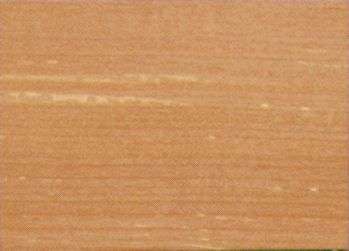
New Zealand silver beech (Nothofagus menziesii)
Family: Fagaceae
Common names: New Zealand silver beech, Silver beech, Southland beech
Distributed in: New Zealand (Oceania and S.E. Asia)
Common uses: Agricultural implements, Boat building (general), Boat building: framing, Boxes and crates, Brush backs & handles, Cabinetmaking, Cooperages, Flooring, Food containers, Furniture, Heavy construction, Light construction, Plywood, Tables, Tool handles, Toys, Turnery, Vehicle parts, Veneer: decorative
Tree size: Tree height is 30-40 m
Colors: the heart isReddish brown, Yellowand the sapwoodWhite to yellow, Yellow.The grain isStraight, the textureMediumand the lusterMedium
Natural durability: Susceptible to attack from powder post (Lyctid & Bostrychid) beetles, Susceptible to insect attack
Kiln Schedules: UK=E US=T6D2/T3D1 Fr=5
Drying Defects: Moderate end spitting, Slight end splitting
Ease of Drying: Moderate
Tree Identification: Bole/stem form is buttressed
Comments: General finishing qualities are rated as good
Blunting Effect: Blunting effect on machining is moderate
Cutting Resistance: Cutting Resistance with dry wood is easy
Gluing: Moderate gluing properties
Nailing: Holds satisfactorily
Planing: Fairly Easy to Very Easy
Resistance to Impregnation: Sapwood is permeable
Response to hand tools: Moderate working qualities
Steam bending: Moderate
Screwing: Screwing yields satisfactory results
; Turning: Good results
Painting: Good; Polishing: Satisfactory; Staining: Finish is generally satisfactory;
- Numerical data Metric
- Numerical data English
- Strength properties
- References
 |
 |
 |
 |
| Item |
Green |
Dry |
Metric |
| Specific Gravity |
|
|
|
| Density |
|
576 |
kg/m3 |
| Bending Strength |
632 |
985 |
kg/cm2 |
| Crushing Strength |
314 |
493 |
kg/cm2 |
| Hardness |
|
424 |
kg |
| Impact Strength |
|
|
cm |
| Shearing Strength |
|
121 |
kg/cm2 |
| Stiffness |
95 |
110 |
1000 kg/cm2 |
| Tangential Shrinkage |
|
|
% |
| Radial Shrinkage |
4 |
|
% |
| Weight |
560 |
448 |
kg/m3 |
| Maximum Load |
|
|
cm-kg/cm3 |
| Toughness |
|
|
cm-kg |
| Static Bending |
|
|
kg/cm2 |
|
 |  |  |  | | Item | Green | Dry | English | | Bending Strength | 8996 | 14020 | psi | | Density | | 36 | lbs/ft3 | | Hardness | | 936 | lbs | | Maximum Crushing Strength | 4468 | 7025 | psi | | Shearing Strength | | 1721 | psi | | Stiffness | 1352 | 1565 | 1000 psi | | Weight | 35 | 28 | lbs/ft3 | | Radial Shrinkage | 4 | | % | | Tangential Shrinkage | 9 | | % | |
Max. crushing strength = medium 0
Density (dry weight) = 31-37 lbs/cu. ft. 0
Modulus of Elasticity (stiffness) = low
Hardness (side grain) = soft
Bending strength (MOR) = low
Shearing strength (parallel to grain) = low
Bending strength (MOR) = medium
Bending strength (MOR) = high
Max. crushing strength = high
Hardness (side grain) = very soft
Density (dry weight) = 38-45 lbs/cu. ft.
Shrinkage, Tangential = fairly large
Shrinkage, Radial = moderate
Shearing strength (parallel to grain) = medium
Modulus of Elasticity (stiffness) = very low
Modulus of Elasticity (stiffness) = medium
Hardness (side grain) = medium
Density (dry weight) = 46-52 lbs/cu. ft.
Max. crushing strength = low
Density (dry weight) = 53-60 lbs/cu. ft
Density (dry weight) = 23-30 lbs/cu. ft.
Bhat, R.V., Guhu, S.R.D.,1951,Indigeneous cellulosic raw materials for the production of pulp,,paper-board prt. II Semi-chemical and chemical pulps from Lannea grandis,(Jhingan,Indian Forester 77(9) pp568-85Bier, H.,1983,The strength properties of small clear specimens of New Zealand-grown,timber,New Zealand Forest Service Forest Research Institute, FRI Bulletin No.41Clifford, N.,1957,Timber Identification for the Builder and Architect,Leonard Hill (Books) LTD. LondonFarmer, R.H.,1972,Handbook of Hardwoods,HMSOForest Products Research Laboratory, U.K.,1945,A Handbook of Empire Timbers,Department of Scientific and Industrial Research Forest Products ResearchForest Products Research Laboratory, U.K.,1967,The Steam Bending Properties of various timbers,Forest Products Research Laboratory, Princes Risborough, Leaflet,No.45Forests Products Research Laboratory, U.K.,1956,A Handbook of Hardwoods,Forest Products Research Laboratory, Princes Risborough, Department of,Science and Industrial Research, Building Research EstablishmentKloot, N.H., Bolza, E.,1961,Properties of Timbers Imported into Australia,C.S.I.R.O. Forest Products Division Technological Paper,No.12Kribs, D.A.,1950,Commercial and Foreign Woods on the American Market (a manual to their,structure, identification, uses and distribution,U.S.A. Penn. State College, Tropical Woods LaboratoryRedding, L.W.,1971,Resistance of Timbers to Impregnation with Creosote,Forest Products Research Laboratory, Princes Risborough, Building Research,Establishment Bulletin No.54 pp.43Reid, J.S.,1953,Beech Timbers,New Zealand Forest Service Information Series No.17Rendle, B.J.,1969,World Timbers (3 Vols.,Ernest Benn Ltd. LondonSmith, D.N.,1959,The Natural Durability of Timber,Forest Products Research Laboratory, Princes Risborough, Building Research,Establishment Record,No.30Smith, S.W. and Entrican, A.R.,1957,Forestry in New Zealand,New Zealand Forest Service Information Series No.1
|








